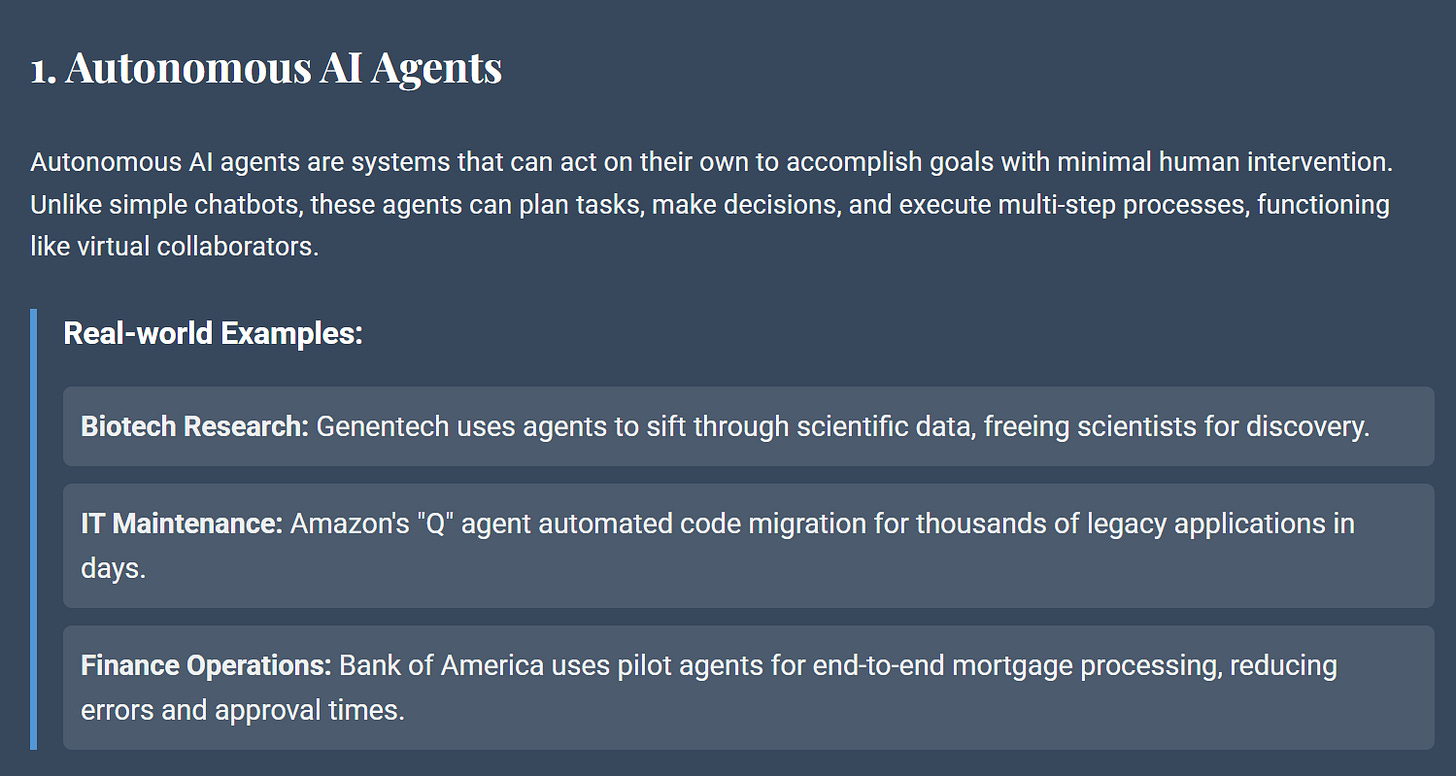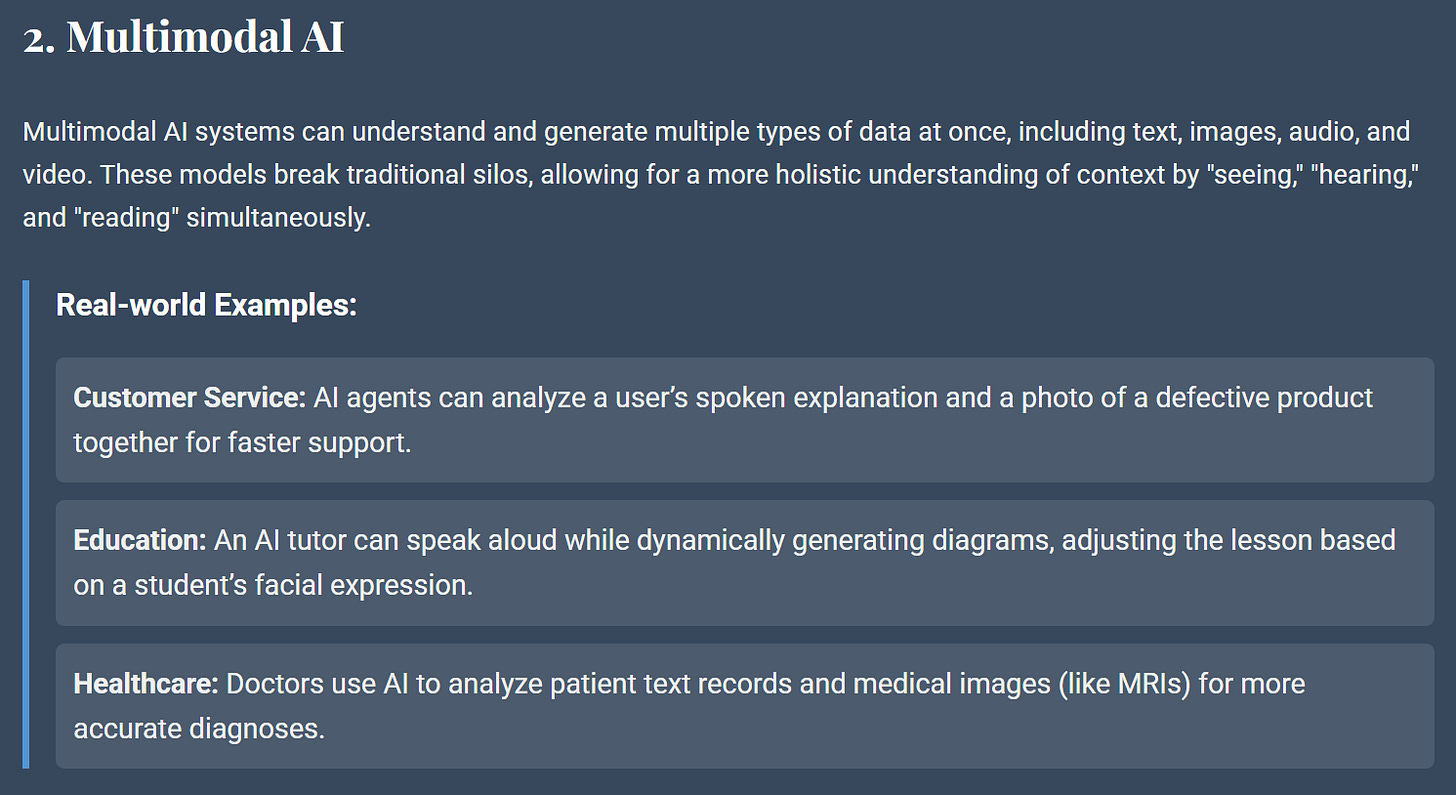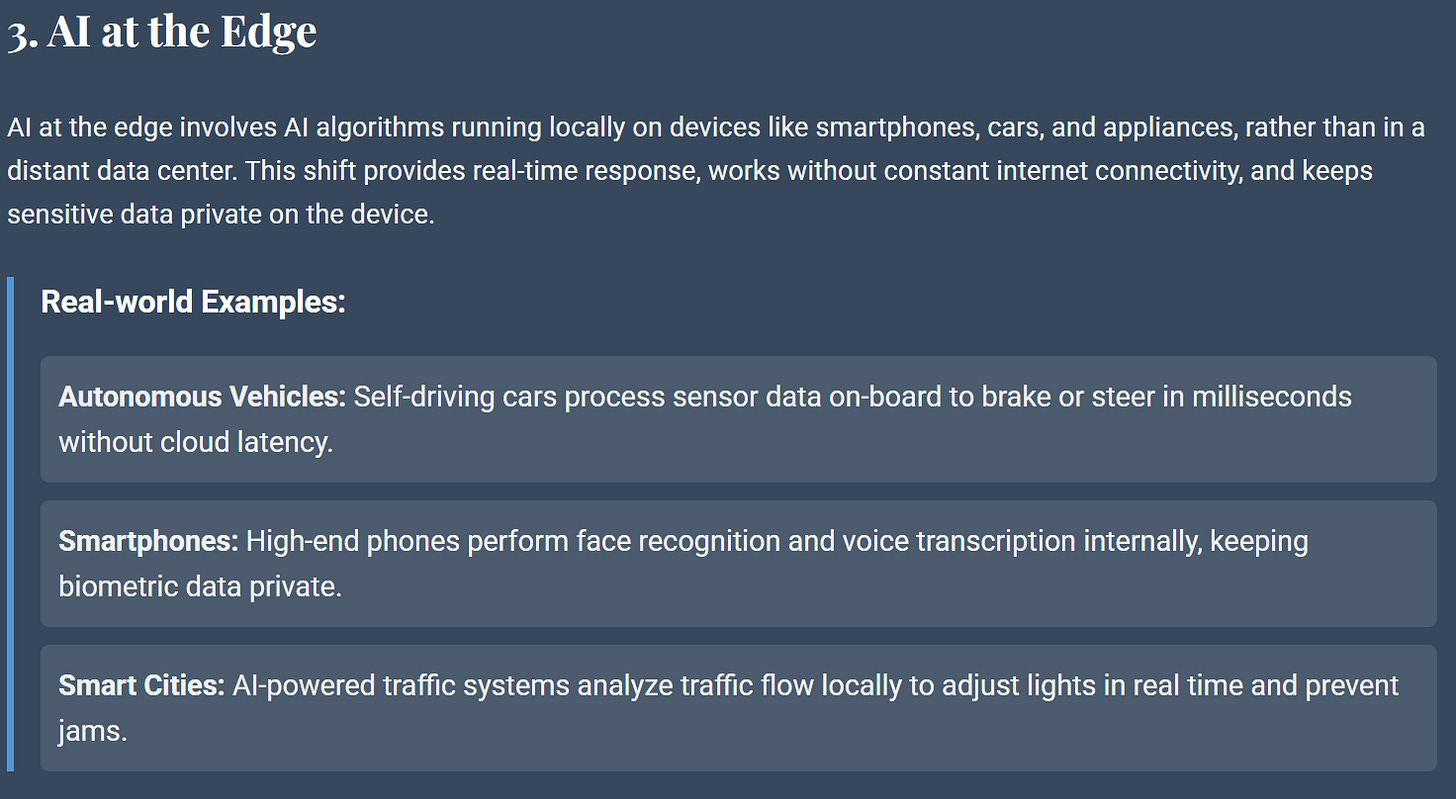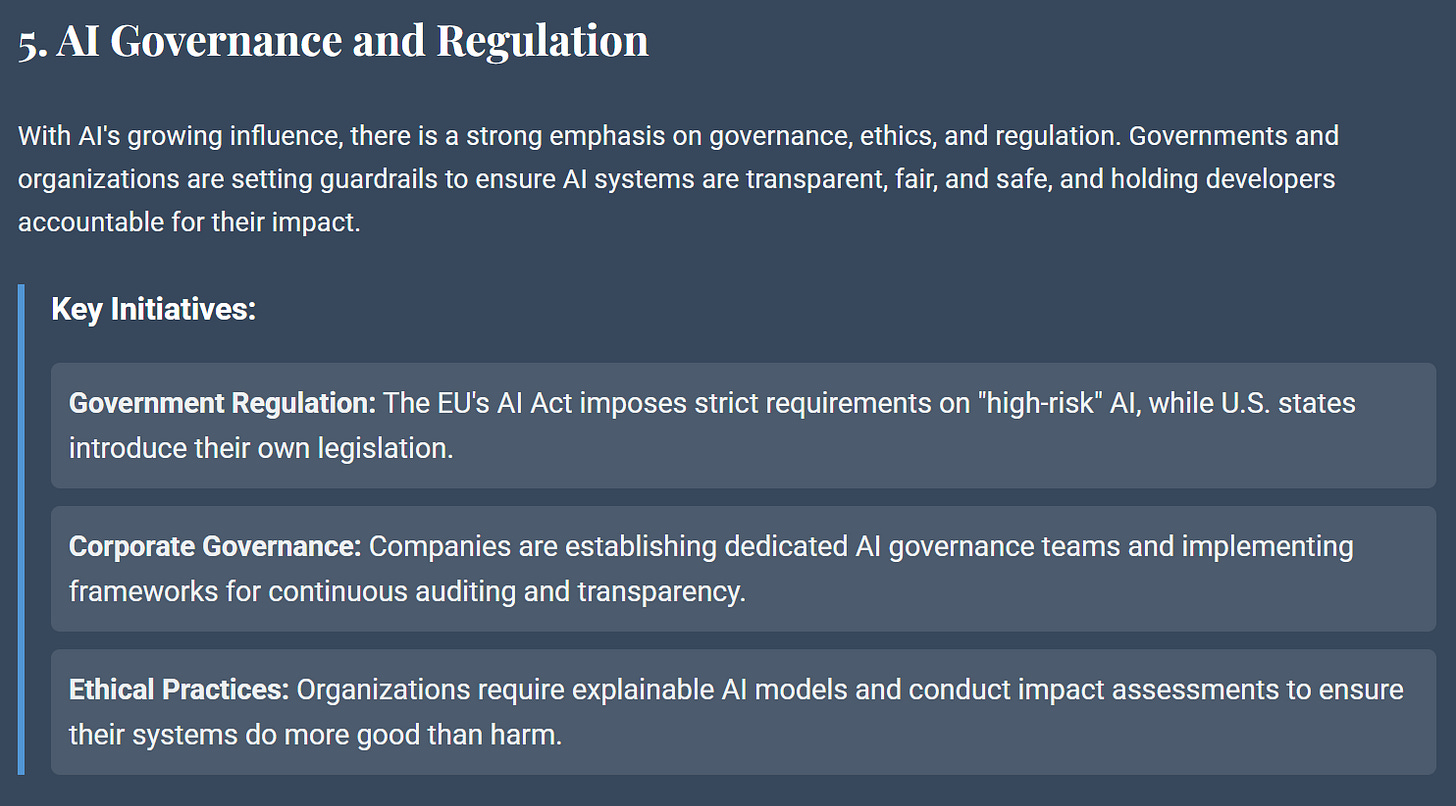The Five AI Trends Already Underway and Will Become Bigger
Don't miss these trends if you want success in the AI industry
Artificial Intelligence (AI) will transform from a buzzword into a widespread reality by 2025. The past few years saw generative AI, like chatbots and image creators, surge in popularity, and now a new wave of AI innovations is developing. These trends, from autonomous AI Agents to new regulations, are changing how we work, interact, and govern technology.
This article explains each trend clearly, provides real-world examples and case studies, and describes why it matters.
The aim is to provide an accessible yet credible overview so that both beginners and experts can understand what’s happening in AI.
Curious about it? Let’s get into it.
Referral Recommendation
Techpresso gives you a daily rundown of what's happening in tech and what you shouldn't miss. Read by 300,000+ professionals from Google, Apple, OpenAI...
1. Autonomous AI Agents
In 2025, autonomous AI agents have emerged, capable of acting independently to achieve goals, unlike simple chatbots that wait for questions. These agents can plan, decide, and execute complex tasks with minimal input, using advanced AI (like large language models) to observe, decide, act (e.g., calling APIs), and learn from results. They act as virtual collaborators, anticipating and performing tasks, not just following scripts.
Real-world examples are emerging. For example:
Genentech uses autonomous research agents to analyze scientific data, helping scientists focus on discovery.
Amazon’s AI agent "Q" automates code migration, completing projects in days instead of months.
Bank of America’s pilot AI handles mortgage processing, reducing errors and approval time by over two days.
An Australian healthcare network uses AI for billing, saving 25,000 hours annually.
These examples show autonomous agents moving from concept to practical applications, taking over routine decision-making in research, IT, finance, and more.
This new AI autonomy presents challenges, such as unpredictability and bias, prompting organizations to implement oversight like ethical guidelines, human reviews, and fail-safes. Despite these issues, over half of the companies surveyed prioritize “agentic AI," with many redesigning workflows to integrate AI copilots.
Autonomous AI quickly shifts from experimental to mainstream, transforming software from passive tools to active workplace partners.
2. Multimodal AI
Another major AI trend is multimodal AI, a system that simultaneously understands and generates multiple data types, not just text. Usually, AI focuses on one area, like language, images, or audio, but multimodal AI simultaneously processes text, images, audio, video, and structured data for a broader context.
By 2025, AI models like GPT-5 and Google’s Gemini will become multimodal, capable of processing images and text and allowing richer interactions. For example,
AI assistants can interpret spoken explanations and photos of defects for faster support.
AI tutors can speak and point to educational diagrams, adjusting for student confusion.
Devices like smartphones now respond to voice, gestures, and visuals, making interactions more intuitive.
In Healthcare, combined text and medical images are used for better diagnoses.
Multimodal AI is transforming industries by integrating data types to improve outcomes. It surpasses previous single-mode AI by providing more context-aware and reliable results, making text-only AI seem limited.
Experts believe most future AI will be multimodal.
3. AI at the Edge
AI is not just cloud-based; a major trend is AI at the edge, where algorithms run locally on devices like smartphones, cars, appliances, and IoT gadgets instead of remote data centers. This shift moves intelligence closer to data sources. Processing on-device or via a local gateway enables real-time responses with minimal delay, does not need constant internet, and keeps sensitive data on the device for privacy.
Why is edge AI becoming the norm? There are a few reasons, including:
Instant decisions for safety-critical uses like self-driving, robotics, and factory control
Resilient when networks are slow or offline
Lower bandwidth and cloud costs as connected devices surge
Privacy is also a key driver of edge AI. It processes personal data locally, reducing leak risks.
The real-world example includes:
Smartphones handle face unlock, voice transcription, and photo enhancement on-device
Wearables analyze vitals locally and alert users immediately
Cities optimize traffic lights from camera feeds processed at intersections
AI at the edge provides faster responses, improved reliability, and enhanced privacy. Advances in semiconductor technology allow even affordable gadgets to run advanced AI models locally. This enables autonomous drones, smart home devices, and AR glasses to operate without relying on the cloud.
Edge AI will become standard in cars, kitchens, and everywhere.
4. Vertical AI Applications
As AI continues to develop, it is becoming more specialized. Currently, a noticeable shift toward vertical AI applications, with solutions tailored to specific industries or issues, is evident.
Rather than using generic AI models, companies are developing specialized models that grasp the language and nuances of their specific industries by focusing on their data's unique details. Consequently, AI is transforming from a versatile tool into an essential component in sectors such as healthcare, finance, law, education, and agriculture, each with customized models and systems optimized for those fields.
Vertical AI is vital because specialized models outperform general ones in domain-specific tasks and reduce errors in critical fields. Examples of vertical AI include:
Imaging assistants, clinical copilots, and drug discovery accelerators like AlphaFold 3.
Fraud detection and risk models; BloombergGPT for parsing financial text; lenders like Upstart using alternative data.
Drafting, review, and compliance tools that understand regulations and speed up routine work.
Retail models like Vue.ai and Lily AI for personalized feeds, recommendations, and dynamic pricing.
Pre-specialized foundations include Google Med-PaLM 2 for healthcare, ChatLAW for legal tasks, and CodeX for software work.
The trend is clear: expertise is merging with AI. An AI that truly understands your industry can transform operations by executing tasks faster, more reliably, and at scale than humans, freeing humans to focus on higher-level judgment.
5. AI Governance and Regulation
As AI becomes part of society, the current era stresses governance, ethics, and regulation. Early on, AI had few rules and quick progress. Now, global efforts aim to establish transparency, fairness, and safety standards while holding developers and users responsible.
Governments are shifting from principles to enforcement now, for example:
EU AI Act: first comprehensive AI law; targets high-risk uses in healthcare, finance, employment, law enforcement; requires audit trails, transparency, explainability, pre-deployment risk assessments; fines up to €30–35 million or a percentage of global revenue.
Risk-based model: Some AI practices are banned, others are tightly regulated, and higher standards for accuracy, bias mitigation, and human oversight are promoted.
United States landscape: no federal AI law exists; all 50 states introduced AI bills in 2025, covering hiring discrimination and deepfakes. Federal guidance from the FDA and FTC addresses medical and consumer AI.
Transparency proposals suggest labeling AI-generated content and regular reporting on training/testing practices.
Other regions, like Canada and China, propose AI and Data Acts, rules on deepfakes and algorithms, with more frameworks expected in 2025.
Equally important is how companies and institutions are adapting to promote ethical AI use. Many are establishing dedicated AI governance teams or officers, distinguishing this role from traditional IT or R&D functions. Notably, leading organizations are now implementing actions such as:
They use monitoring systems for continuous AI audits, checking outputs for bias or errors and logging decisions for traceability.
Explainability and transparency require AI models, especially in critical decisions like lending or hiring, to provide human-interpretable explanations for their outputs (e.g. highlighting factors leading to a loan denial).
Impact assessments are formal evaluations of an AI system's impact on users and society conducted before and after launch to measure outcomes and ensure benefits outweigh harms.
While governance might not be the most thrilling trend, it’s crucial as AI’s influence becomes increasingly widespread. Ultimately, this trend seeks to ensure AI's credibility as it plays a larger role in decision-making in our daily lives.
Love this article? Comment and share them with Your Network!








